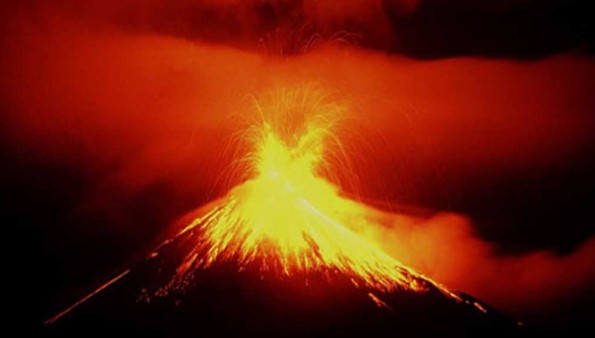Archive
Supervolcano plume sized up
 University of Utah
University of Utah
This image, based on variations in electrical conductivity of underground rock, shows the volcanic plume of partly molten rock that feeds the Yellowstone supervolcano. Yellow and red indicate higher conductivity,green and blue indicate lower conductivity.
By John Roach
The volcanic plume beneath Yellowstone is larger than previously thought, according to a new study that measured the electrical conductivity of the hot and partly molten rock.
The findings say nothing about the chances of another cataclysmic eruption at Yellowstone, but they give scientists another view of the vast and deep reservoir that feeds such eruptions.
“It’s a totally new and different way of imaging and looking at the volcanic roots of Yellowstone,” study co-author Robert Smith, an emeritus professor Read more…
Yellowstone supervolcano, new Ice Age could topple US government
 As evidence mounts that the world may fast be slipping into the next Ice Age, Washington insiders are hurrying to solidify a new power base for centralized government operations.
As evidence mounts that the world may fast be slipping into the next Ice Age, Washington insiders are hurrying to solidify a new power base for centralized government operations.
Fears that the US capital might be struck by another more deadly terrorist attack—or other disasters—prompted agencies a decade ago to hurriedly establish back-up operations in case catastrophe struck.
Despite the fact that many conspiracy theories are weaved around the subjects that follow—including some fairly wild-eyed, tin foil hat scenarios—most conspiracy theories have a basis in fact, although the facts are distorted or wildly exaggerated.
The actual story of the Denver airport, the nation’s “second capital,” the impending Ice Age possibility, and the threat the Yellowstone supervolcano presents to the people of the United States of America and their government follows: Read more…
Eruption Of Colima Volcano

A light colored plume, probably the result of rockfall on the dome, extends to the east (right) of the summit. The summit crater is the remnant of an explosive eruption in 1913 which knocked 100 meters (300 feet) off the top of the mountain. For a larger version of this image please go here. by Staff Writers
Washington DC (SPX) Jan 28, 2011
Colima Volcano, Mexico’s most active, has been erupting since 1998. The eruption began with several months of earthquakes beneath the volcano, followed by explosions and rockfalls at the summit lava dome as it began to grow.
Dome growth was accompanied months later by a series of lava flows which cascaded down the southwestern flank of the mountain, stretching up to 3,100 meters (10,000 feet) from the summit.
Since then dome growth has continued, with a few periods of actively flowing lava. As of March 2010, the dome was growing about 2,000 cubic meters (70,000) cubic feet a day, leading to frequent small rockfalls and occasional ash plumes. In January 2011, local newspapers reported “dust plumes” rising over Colima, likely pulverized lava stirred up by landslides at the summit dome. Read more…
All the volcano webcams of the world
Pacific
Kilauea – info – webcams: Pu’u O’o | Thanksgiving Eve Breakout | Halema`uma`u Crater from HVO | Halema`uma`u Crater overlook
Mariana Islands (United States)
Western/Southern Pacific
Yellowstone Supervolcano Bulges 10 inches as Magma Pocket Swells
Brian Handwerk



![[Most Recent Quotes from www.kitco.com]](https://i0.wp.com/www.kitconet.com/charts/metals/gold/t24_au_en_usoz_2.gif)
![[Most Recent Quotes from www.kitco.com]](https://i0.wp.com/www.kitconet.com/charts/metals/silver/t24_ag_en_usoz_2.gif)

You must be logged in to post a comment.